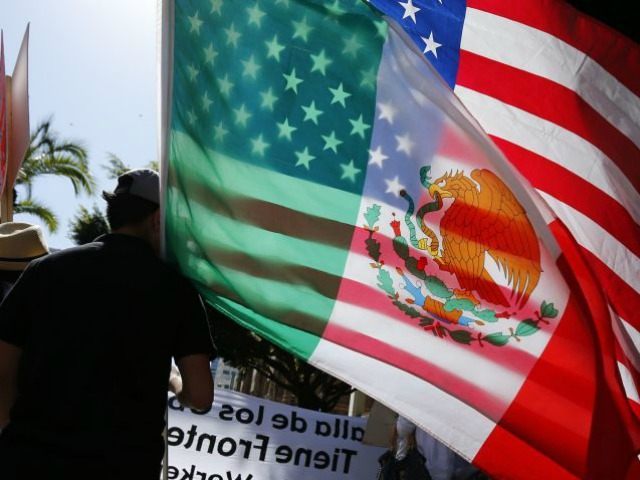It is one of the few places on earth where nothing but a line on a map separates the third world from the first. A line that allows some to live in abundance while condemning others to a life sentence of squalor A line that separates the land where the dreams can come true from one where dreams are the exclusive domain of a wealthy few. A line that marks the transition from a nation that is recognized for its economic and political stability to one that is just as notorious for its economic and political instability.
That line is the border between the United States and Mexico.
But it is more than a line separating two countries. It is a boundary separating two philosophies that can trace their origins back to the Roman Empire and the Germanic tribes that resisted their autocratic rule.
By the time Columbus set sail for the New World, Spain had revived the Roman political system. The government was very centralized and the state, in the form of the king, was above all. Her kings had the same authority over his subjects as that of the most powerful Caesar. The principles of divine right meant that he, the king, was chosen by God to rule his people with absolute authority. This was reinforced by the revived Roman church, which constantly preached that to disobey the king not only endangered your life, but also condemned your immortal soul. This made the king owner of all within his domain, including the people. The duty of the common man was to obey his king and pay his taxes. He had no rights, not even to life itself. The state dominated, if not controlled all economic activity, which would result in Spain having a peasantry until the 1970s.
The Saxon tribes that resisted Roman subjugation had a very different political culture. Their leader was often elected and his authority was limited by a body of elders. The king was considered the first among equals and he served his people rather that the other way around. Thus, he was subject to the same laws as the common man and although taxation existed, especially in times of war, there were limits on the power of the king to impose taxes. Individuals had rights and judicial punishment was decided by a body of peers. Most importantly, freemen owned property in their own right and the government had very little influence on the economic activity of his people. This form of government would make its way to England and by the time of Columbus would make the values of the English people very distinct to that of continental Europe. England would develop a classical liberal style of government based principles of limited government, individual rights, private property, and free-market economics.
While Romanized Spain was conducting its Inquisition, enslaving the native populations of the New World, and exploiting its people, England was waging a war, both internally and externally, against arbitrary rule. This struggle for individual freedom would result in documents such as the Magna Carta and the Declaration of Rights of 1689. These documents, which could never be produced in Romanized Spain, became the foundation of freedom in the United States and Canada. Thus, making them as free and prosperous as England herself.
This was no surprise to Alexis de Tocqueville, who observed nearly two centuries ago that colonies inherited their political culture from their colonial masters. And while North America inherited liberty from their English masters, the Spanish colonies were bequeathed Roman authoritarianism. As we have seen throughout the history of Latin America, local despotism immediately replaced that of their former masters
Politics of the cuadillo, or strongman, became the dominant form of government with little Caesars having unlimited power over their people. The people themselves were nothing more than chattel to be exploited by the elites. As one Mexican adage puts it, “Mexico is a ranch and the president is the owner.”
Such a political culture could not produce a Washington, a Jefferson, or an Adams. It could only give birth to despots such as Santa Ana, Iturbide, and Porfirio Diaz in Mexico and, more recently, Castro in Cuba and Chavez in Venezuela. Nor could it allow the economic freedom that has produced the prosperity enjoyed by their northern neighbors. The result being that peasantry, which the English colonies never had, is still present throughout Latin America.
This is why there is so much disparity between the Saxonized United States and Canada and their Romanized neighbors to the south. One side unleashes the potential of the individual, creating freedom and prosperity for the society as a whole. The other sees the common man as nothing more than a subject, there to serve the needs of the elite controlled state. One becomes a flourishing modern democracy with a vibrant financial system, while the other remains stagnant with a peasant-style economy.
A Mexican anecdote tells the tale of a girl who was visiting her cousins north of the border for the first time. As they drove around sightseeing, her cousins explained that it was all once part of Mexico but that the Americans took it. The girl, upon looking at the affluence, sorrowfully remarked, “And they took the best part, too”.
Unfortunately, that is how most people see the differences between the two nations; never understanding the root causes for the economic inequality that exists between the United States and Mexico can be found in their political cultures.
John L. Hancock is a fellow of the American Freedom Alliance and the author of Liberty Inherited (CreateSpace, 2011). He will be a participant in the AFA sponsored international conference Magna Carta; The 800 Year Struggle for Human Liberty in Los Angeles this weekend.

COMMENTS
Please let us know if you're having issues with commenting.